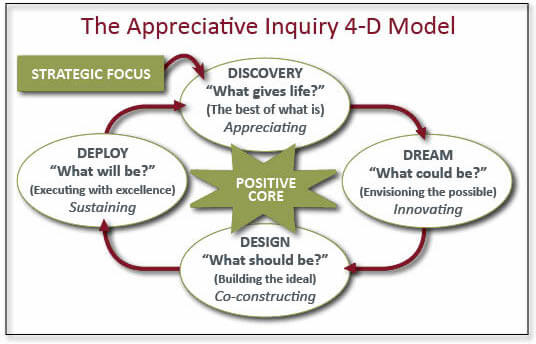Learn the basics of Appreciative Inquiry in this article, and find Appreciative Inquiry examples and resources.

Appreciative Inquiry (AI) is a strengths-based, positive approach to leadership development and organizational change.
AI can be used by individuals, teams, organizations, or at the societal level; in each case, it helps people move toward a shared vision for the future by engaging others in strategic innovation.
An individual might use Appreciative Inquiry for leadership coaching or to develop a personal strategic vision. Teams and organizations use AI to understand best practices, develop strategic plans, shift culture, and create forward momentum on large-scale initiatives. At the societal level, Appreciative Inquiry has been used to find common ground around topics of global importance, to shape the direction of non-profits and NGOs, and to form multi-national initiatives that spans geography and industries.
Join us
March 4, 2021
Leading Change with Appreciative Inquiry
45-minute webinar
March 25, 2021
Appreciative Inquiry for Strategic Planning
One-Day workshop
Appreciative Inquiry has been used globally by public and private organizations of all sizes, including to address sales growth at Merck; to improve customer service at British Airways; to pursue sustainable value creation with Wal-Mart; to develop leadership in the United States Navy; to redesign organizational divisions at World Vision; and to improve cost, quality and cycle time at John Deere.
AI can be used in 1:1 meetings, with small and medium-sized groups, or in large-scale change initiatives that include thousands of people. It can be deployed in-person or at-a-distance through the use of technology. The length of engagement varies from days to months to years, depending on the breadth and depth of the topics being explored and the number of people involved.
Download our Appreciative Inquiry eBook
What makes Appreciative Inquiry different from other organizational change models?
AI distinguishes itself from other organizational visioning and change models by focusing on the best of what is and using this as a platform to build future directions. While many traditional methods begin by focusing on pitfalls and problems, Appreciative Inquiry asks people to explore strengths and successes that already exist, both internally and externally. This positive approach leads to extraordinary performance by reinforcing relationships and culture, creating common vision and direction, promoting learning and innovation, and energizing collective action.
What are the components of an Appreciative Inquiry process?
Whether you’re using Appreciative Inquiry one-on-one, or with 1,000 people, the AI process will follow four distinct phases, called the 4-D Cycle:
- Discovery: participants explore “the best of what is,” identifying the organization’s strengths, best practices, and sources of excellence, vitality, and peak performance.
- Dream: participants envision a future they really want – a future where the organization is fully engaged and successful around its core purpose and strategic objectives.
- Design: participants leverage the best of what is and their visions for the future to design high-impact strategies that move the organization creatively and decisively in the right direction.
- Destiny (sometimes also called Deploy): participants put the strategies into action, revising as necessary.

Example: Imagine you’re a manufacturing company that wants to develop your capacity for innovation in order to expand research and development, and earn more marketshare. In this example, your strategic focus (also called the affirmative topic) would be improving innovation.
In the Discovery phase, you’d find examples of when your company has been at its best around innovation, and then identify the common factors in these stories.
Next, in the Dream phase, you’d invest time in thinking about what a truly innovative organization would look like: How would leaders, resources, behaviors, the physical space, organizational processes, etc., change? You’d work to create a vision of the future that is invigorating and inspiring, something you truly want.
Once your vision for the future is clear, the next phase will ask you to Design the future. What steps are needed today, to reach that vision? In the design phase, you get as strategic and tactical as possible, creating models and prototypes of different elements of your future, mapping steps, identifying required resources, and engaging the support of others.
Finally, in the Destiny phase your team will work to implement your design, to make the vision a reality.
Need help leading your Appreciative Inquiry initiative? Our world-class facilitators can coach you through your process. Email info@cvdl.org for more information.
What is the theoretical framework of Appreciative Inquiry?
Appreciative Inquiry has its theoretical framework in positive psychology and positive organizational scholarship. First developed by David Cooperrider and colleagues at Case Western Reserve University, AI has since been employed and tested by scholars and practitioners around the world.
Three concepts form the foundation, sometimes called the “three-legged stool” of Appreciative Inquiry: appreciation, inquiry, and wholeness.
- Appreciation: To appreciate is to recognize the best in people, or the world around us. Appreciative Inquiry draws on the strengths of individuals and organizations. These strengths become the foundation on which the future can be built.
- Inquiry: To inquire is to ask questions.The 4-D Cycle invites participants to ask questions so they can learn from one another, and together identify a shared vision of the future. Participating in an AI process requires an attitude of curiosity and a hunger for discovery.
- Wholeness: The final AI tenant of wholeness encourages participation from all levels of an organization, knowing that the best ideas often emerge from unexpected places. Additionally, AI encourages seeking outside perspectives. It is a whole-system process.
Where can I find more resources for practicing Appreciative Inquiry?
Appreciative Inquiry books and resources can help you grow your knowledge of the methodology. We recommend the following:
- Our free ebook, Six Questions that Can Lift Your Leadership, which explores the questions asked throughout an Appreciative Inquiry process.
- The Appreciative Inquiry Summit, a resource book for practitioners leading large-scale change, written by the Center’s Dr. Jim Ludema with Diane Whitney.
- The Power of Appreciative Inquiry, an introductory book by Diane Whitney and Amanda Trosten-Bloom.
- Learn to ask the right questions with this blog post.
- Appreciative Inquiry has its origins in a 1987 article: Cooperrider, D. L. & Srivastva, S. (1987). “Appreciative inquiry in organizational life”. In Woodman, R. W. & Pasmore, W.A. Research in Organizational Change And Development. Vol. 1. Stamford, CT: JAI Press. pp. 129–169.
Additionally, the Center for Values-Driven Leadership offers an Appreciative Leadership Executive Workshop Series, along with customized consulting and workshops for companies and organizations. Find more Appreciative Inquiry leadership development, coaching, and executive education options on our website at this link.
Request more information
Tell me more about the Appreciative Leadership Workshop Series:

